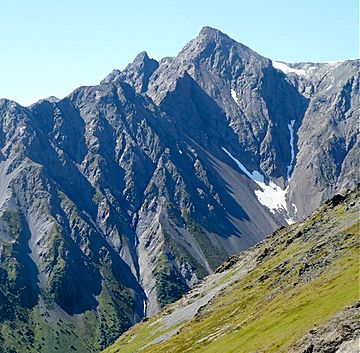Lowell Peak facts for kids
Quick facts for kids Lowell Peak |
|
|---|---|

North aspect seen from Marathon Mountain
|
|
| Highest point | |
| Elevation | 4,416 ft (1,346 m) |
| Prominence | 741 ft (226 m) |
| Isolation | 1.4 mi (2.3 km) |
| Parent peak | Marathon Mountain |
| Geography | |
| Location | Chugach National Forest Kenai Peninsula Borough Alaska, United States |
| Parent range | Kenai Mountains |
| Topo map | USGS Seward A-7 |
Lowell Peak is a mountain in Alaska that stands about 4,416 feet (or 1,346 meters) tall. It's located in the Kenai Mountains, on the Kenai Peninsula. This peak is part of the huge Chugach National Forest.
The mountain is about 1.2 miles northwest of Bear Mountain. It's also about 1.5 miles south-southwest of Marathon Mountain. Lowell Peak is around 2.2 miles south of Phoenix Peak and 3 miles west-southwest of the town of Seward, Alaska.
The best time to see Lowell Peak is usually in May and June. The weather is often clear and sunny then. From the top of the mountain, you can see the amazing Harding Icefield. You might also spot Mount Alice across Resurrection Bay.
This mountain doesn't have an official name. However, it is called Lowell Peak after Franklin G. Lowell and his family. They were the first people to settle in the Seward area back in 1883.
What is the Weather Like at Lowell Peak?
Lowell Peak is in a place with a subarctic climate. This means it has very long, cold, and snowy winters. The summers are usually mild. Temperatures can drop below -20 °C (which is -4 °F). With the wind, it can feel even colder, sometimes below -30 °C (-22 °F).
Glaciers and Water Flow
Because of the cold climate, there is an unnamed glacier on the west side of Lowell Peak. A glacier is a large, slow-moving river of ice.
Water from the north side of the mountain flows into Lowell Creek. Water from the south side flows into Spruce Creek. Both of these creeks eventually empty into Resurrection Bay.


